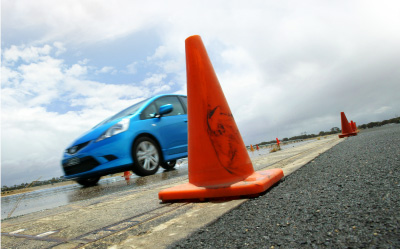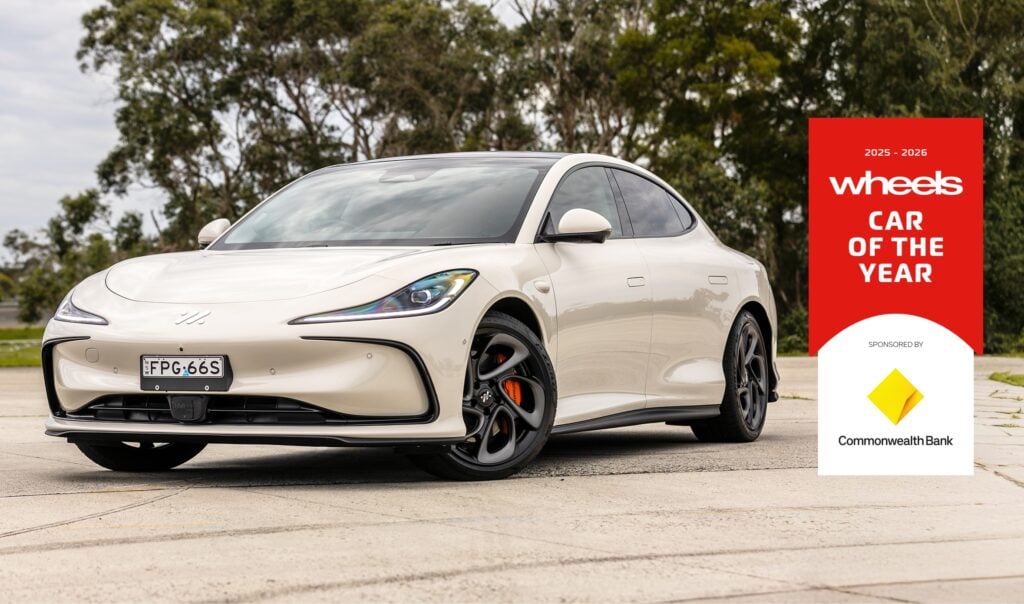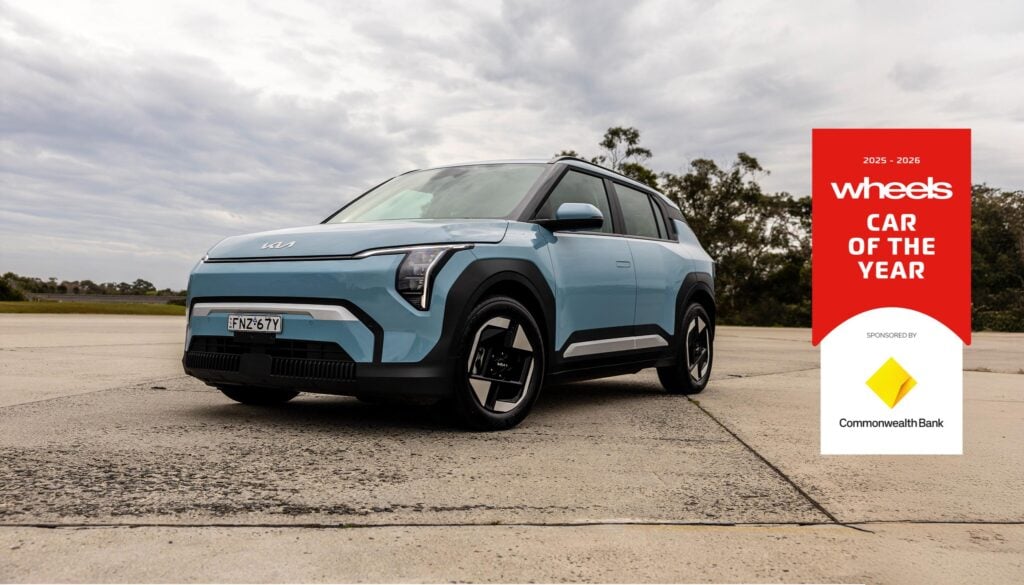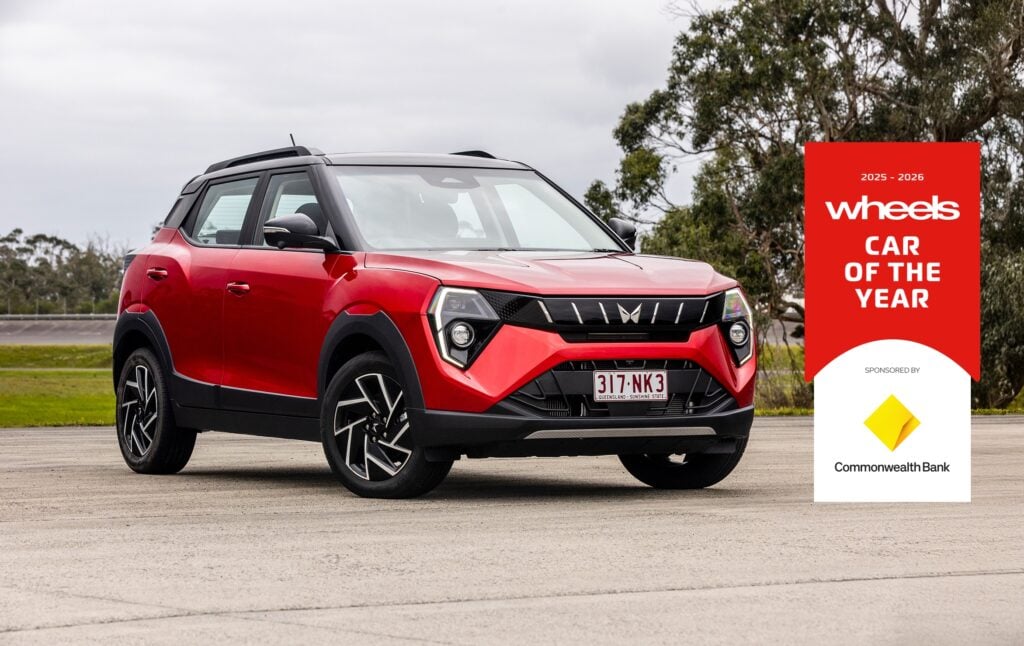In 2007 it was stifling heat, swarming flies, emotional anguish and ultimately, a well-engineered but conventional sedan winning COTY.
This time, it was arctic winds, limb-sawing sleet, serial hailstorms, lost car keys … and penultimately, three out of the four COTY finalists were also well-engineered, conventional sedans.
It had been a fire-and-ice sort of year, of course. We went into the seven-day exercise, held initially at Ford’s You Yangs Proving Ground near Geelong, and later in the lovely Macedon Ranges, north-west of Melbourne, in late-2008. While we drove, the global automotive industry wasn’t just dealing with shifting goalposts; the footy field itself looked like being redeveloped for condos.While we were in Geelong, Ford Australia’s local engine plant was granted a three-year reprieve, spreading palpable relief through the town. But around the same time, the Ford Motor Company’s capo-dei-capi Alan Mulally, GM’s Rick Wagoner and Chrysler’s Robert Nardelli had flown to Washington (infamously, on their private jets) to seek a US$18b life-support package.We were sharply aware that COTY ’08 coincided with a turning point in economic and automotive history.We began the process with 18 models in a total of 53 variants. They’re all assembled somewhere on these pages, in a photograph taken on the You Yangs skidpan in the wickedly polar weather mentioned earlier. This was our first trip back to the You Yangs since COTY 2005, Ford having opted to keep its impressive new FG Falcon under wraps throughout its development. COTY this year featured an all-new road route, centred on the pretty Mt Macedon township of Woodend.Looking at the assembled field, it occurred to me that people still like sedans. To my way of thinking, the crossover craze had reached a new zenith – or hopefully, nadir – during 2008 with the BMW X6, a coupe-four-door-truck-sports-thing appealing to 65-year-olds with ponytails.And yet at COTY, quite conventional, three-box sedans accounted for eight of the 18 models assembled (Audi A4, Ford Falcon, Honda Accord, Honda Accord Euro, Jaguar XF, Mazda 6, Mercedes-Benz C63 AMG and Mitsubishi Evo X). Three more were hatchbacks (the Mitsubishi Lancer Sportback, and the Peugeot 308 and Honda Jazz). Three were SUVs (Subaru Forester, Volkswagen Tiguan and the seven-seat Mazda CX-9), one a station wagon (Peugeot 308 Touring), one a one-box coupe and cabriolet (Smart ForTwo), and BMW gave us the 1 Series Coupe and Convertible, treated here as two different models.There was certainly a notable number of diesel engines among the variants (eight among five models). But aside from the obviously growing trend to compression ignition, there were no gender-bending, category-morphing, flux capacitor-powered, multiply util-active sedoupés.Aside from the Peugeot 308 Touring, a compact wagon trying to seat seven, the weirdest thing here was the new Smart ForTwo, but it’s really no weirder – only a little bigger – than its predecessor.Therein lay another trend that I, for one, began to question during Day One’s introductory walk-arounds.It’s an accepted fact that cars get bigger and heavier each year; some of it’s human growth, some of it’s safety and comfort, much of it’s marketing. Typically, each of our contenders this year had put on five to 10 percent more poundage over their predecessors.As editor and judge Ged Bulmer pointed out, “the number of cars in the past four or five years that have actually lost weight, you’d probably count on one hand.” (Last year’s Mazda 2 was the first that came to mind.)But in the ’08 atmosphere of automotive overhaul, I wondered aloud if COTY judges might one day applaud the omission of air-conditioning, CD players, satellite navigation and a bouncy-castle complement of airbags.It may not be far off: GPS-activated, collision-avoidance systems and (perhaps inevitable) external speed controls could revolutionise passive-safety design. Ever-improving electric steering already points the way for X-by-wire systems far lighter than hydraulics. Electronic miniaturisation means a car can provide all your personal entertainment, connectivity and navigation needs, with a single socket; everything’s already in your mobile phone.Someone could make a cheap, minimalist, manual-windowed car right now, but who’d buy it? Well, Europeans already are: the Dacia Logan is one of the fastest-selling cars on the continent. Not to mention its success in South American and Asian.Our judging debates included the expected old rivalries, and two fresh voices.Wheels staffer Sean Poppitt is already experienced in the COTY cause, having previously run errands and retrieved kangaroo carcasses for the judging team. Quick, keen and knowledgeable, Poppitt also spins off more similes than a, uhh … well, he’s a lot better than I am with similes.Our other new COTY judge is one of the country’s most credentialed racers. Two months earlier, only an engine failure at the final round of the Australian F3 championship had prevented Leanne Tander from becoming the first woman to win Australia’s premier driver’s championship.Tander brought a fresh perspective to the judging, along with effortlessly elegant wheel-twirling skills and the neatest handwriting ever seen in COTY. Glancing at her notes, Bulmer remarked: “Wow, definitely a gold star.”Leanne responded: “At least I get one Gold Star this year.”She clearly enjoyed the challenge. “I didn’t have any preconceptions about the cars or anything at all,” she said. “There’s so much to absorb about every car, my head’s about to explode. Everybody here looks at cars in a completely different way than I ever have … for me, noise isn’t normally an issue. It’s either good noise or bad noise.“But I can definitely assess how they handle, how they respond to braking and steering inputs, acceleration… You want to make a good decision, because a lot of people look to COTY to assist them. I’ve always held it in high regard from a reader’s perspective, so I want to make sure the thing I vote for is worthy.”Our two days of driving at You Yangs began with a shot-peening from 3mm hailstones. It happened twice more during the day, and the weather was barely better the next, as the nine judges continued to work through the 53-car conveyor-belt of durability circuit, dirt circuit, 100km/h wet-stop, 80km/h lane-change, ride and handling circuit, then a few furious minutes of note-taking.It’s a lot of cars to plough through. And plough some did.Subaru not long ago almost had a stranglehold on COTY; every Liberty that came along was a strong contender. But its recent foot-shooting festival continued with the spacious, practical but dynamically disappointing Forester. Carey summed it up best: “The atmo version is blancmange, and the Turbo is blancmange with a sparkler on top.”Similar disappointment oozed over the cat-caricature Peugeot 308 hatchbacks, the Jocelyn Wildenstein of automotive feline grace. Aside from needing to astral-chart Peugeot’s Australian line-up of variants, we all lamented the driving enjoyment of bygone Peugeot hot hatches, if not their bygone plastics and build quality.With an extra two seats and 100mm in the wheelbase, the 308 Touring was treated as a separate model. And it deserved to be. Vastly better to drive than the hatch, and making an admirable attempt to squeeze seven seats into a compact package, it found two champions in myself and Bruce Newton. We had won two more converts come the end of Round One, but it wasn’t enough.Bulmer, who had criticised the usefulness of the Pug’s rear-most row of seating, had no qualms with the Mazda CX-9. Most judged this full-sized seven-seater’s quality and dynamics to be the equal of far costlier German rivals. Until broken-record Carey brought up, as he does every year, a slightly less costly (and COTY-winning) Australian rival, the Ford Territory.If near-criminally clever packaging impresses, lift the tailgate of the new Honda Jazz. And hold onto something, lest you be sucked into the vortex before you. The 1.5-litre manual was a hoot to drive, but the marginally performing 1.3 auto (destined to be the most popular version) was further handicapped by poor tyres. That was one safety setback; the lack of ESP availability in the range would assume the presence of a Chokito floating in the Jazz’s swimming pool.Jaguar’s sleek XF, which we tasted in four flavours, including petrol and diesel, was a walk-up winner for Rear of the Year. That its engines are basically a generation behind German rivals ended up drawing little negative comment, other than the weakest-link petrol V6. We were appropriately surprised/delighted by the innovative cabin lighting and pop-up gear selector, which sparked a typical COTY exchange:“It’s very gimmicky,” said one judge.“Yes, but it works,” said another.“For how long?” asked yet another.On the dirt circuit, BMW’s little 1 Series Coupe was more fun than a bathtub full of Kylies. But it seemed to have an identity crisis, with the atmo 125i being the more balanced and entertaining drive. “The [twin-turbo] 135i’s performance is really nearing the edge of its chassis envelope,” Hawley ventured.Tander broke a Convertible. Whooshing around the dirt circuit, the 120i snagged something and was rendered hors de combat with a bent lower control arm. Thereafter it sat next to the Emissions shed, cocking its leg.Robinson, eyeing it there, conceded: “I think the Coupe and the Convertible are the best-looking 1 Series. But that’s not saying much at all.” Those who had been judges last year recalled the VW Eos, and the 1 Series Convertible was suddenly put in its place.So, too, the second-generation Smart ForTwo, which also is the best example yet. And which also isn’t saying much.The most evocative drives at You Yangs were unquestionably the Mercedes C63 AMG, the mental Mitsubishi Evo X and its milder and admittedly less dynamically talented little brother, the Lancer Ralliart.The Mercedes, with a genetically-modified link to the reigning COTY, came closest of the performance cars to making the trip north to Woodend.In the end, those that advanced after the first vote on the morning of Day Four were:Audi A4: a revelation, especially after our underwhelming experience of the same platform under the A5/S5 coupe just 12 months earlier. Ford Falcon: impressive for its ride, interiors and value, and strangely, more at home on the road than at ‘home’. The G6E Turbo is utterly world-class. Honda Accord: competent, comfortable, quality within and without, they’re like Camrys with character – and just as affordable. Honda Accord Euro: 10 percent heavier than the sweet, outgoing model, but compensates with greater refinement in just about every area. Honda Jazz: a triumph of packaging, and a lesson to others that an inexpensive car doesn’t have to look and feel cheap. Mazda 6: zoom-zoom with five-seater room; an enjoyably edgy drive, with a people-pleasing range of body styles and the option of a diesel. Volkswagen Tiguan: the GTI of SUVs; in fact, more entertaining on-road than a lot of ‘hot’ hatchbacks. Inoffensive enough everywhere else.Thus, seven models in a total of 17 variants convoyed along the delightful inland route from Geelong, via Bacchus Marsh and Gisborne, to Mount Macedon. Farther north, it’s a road that Robbo knows very well: “Thirty-five years ago, I used to do this drive a lot – and very, very fast,” he said. “It’s better heading south, with the ground falling away in front of you as you run along the ridge.”The weather, too, was showing the delightful Macedon Ranges at their best. It was low-20s and gloriously sunny, and after a quick lunch – no other kind at Car of the Year – at our Holgate Brewhouse boutique digs, the two-up road loops began.Our effervescent organiser, Jenny Lamattina, had mapped out a 47.5km loop that took in stretches of freeway, slow urban driving, open highway, ascents and descents, offering an admirably broad menu of road surfaces. Each lap took around 40 minutes. From a tourist’s point of view, the route also took in Hanging Rock (which, Robinson tried to explain, is not based on a true story), and the famous, short stretch of Straw’s Lane where cars seem to roll uphill.Several mystical things were to be revealed over the next 24 hours: how the Audi A4 gets better with the less money you spend; how Ford’s Falcon seemed to have been born for these roads; how the Volkswagen Tiguan’s ride quality is supernaturally sensitive to tyres and how its optional, automatic reverse-parking system is so lifelike, it even cruises around for hours looking for a parking spot; how, despite the nuances of Holgate’s boutique-brewed Big Reg Lager, Double Trouble and The Hopinator, their imbibers end up speaking almost identical drivel.Meanwhile, our final four cars had frothed to a head.As you’ll see, they were the Audi A4, Honda Accord Euro, its separated-at-birth Hiroshima cousin the Mazda 6 and the VW Tiguan. Three fairly conventional sedans and an SUV.The ultimate selection would occur after another day of four-up testing. It was fully obvious to judges that this was going to be a very difficult decision. Said Bulmer, “I don’t remember the last time we had such a close group of contenders.”Added Robinson, “It’s so very tight this year, but mostly because there isn’t a truly standout car. There are several very, very good cars, but nothing that changes the game.”In a context far larger even than COTY, in boardrooms from Michigan to Mumbai to Munich, the game had already been changed forever.





